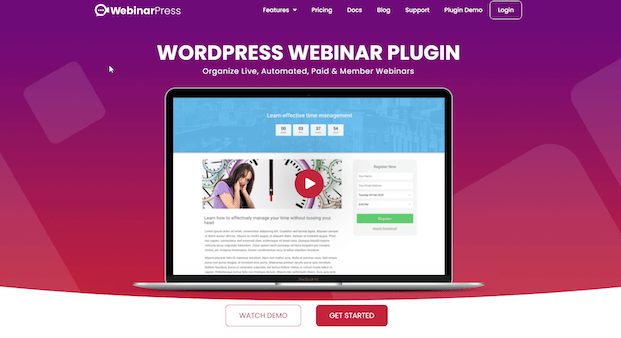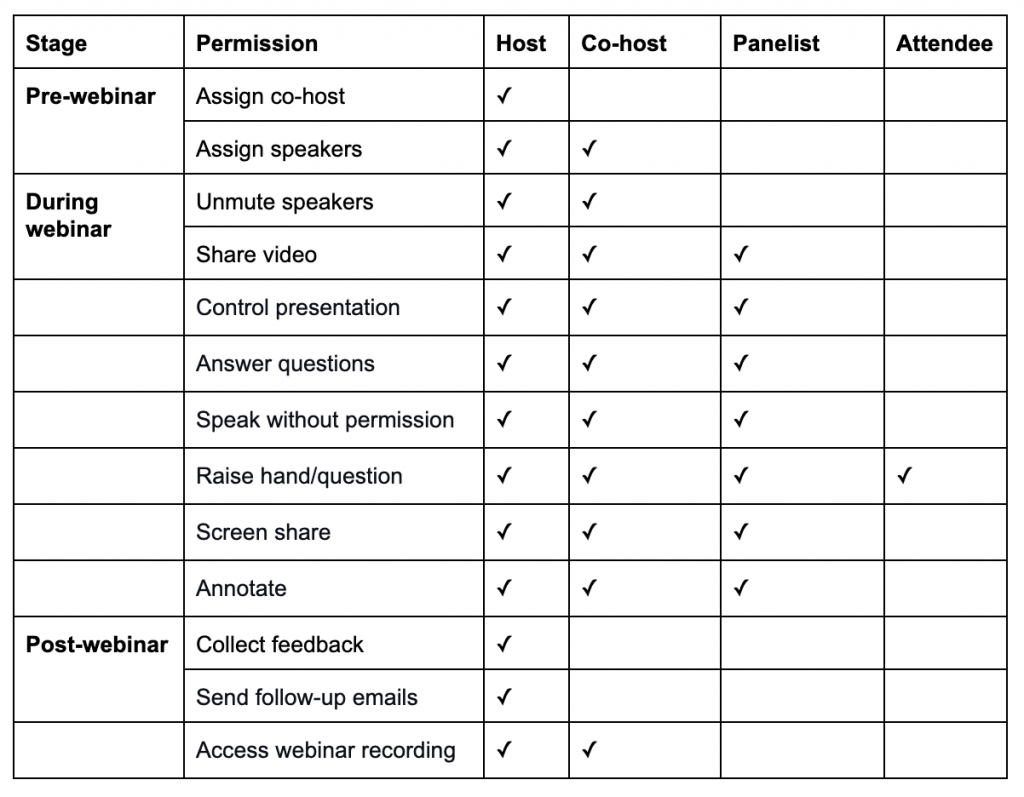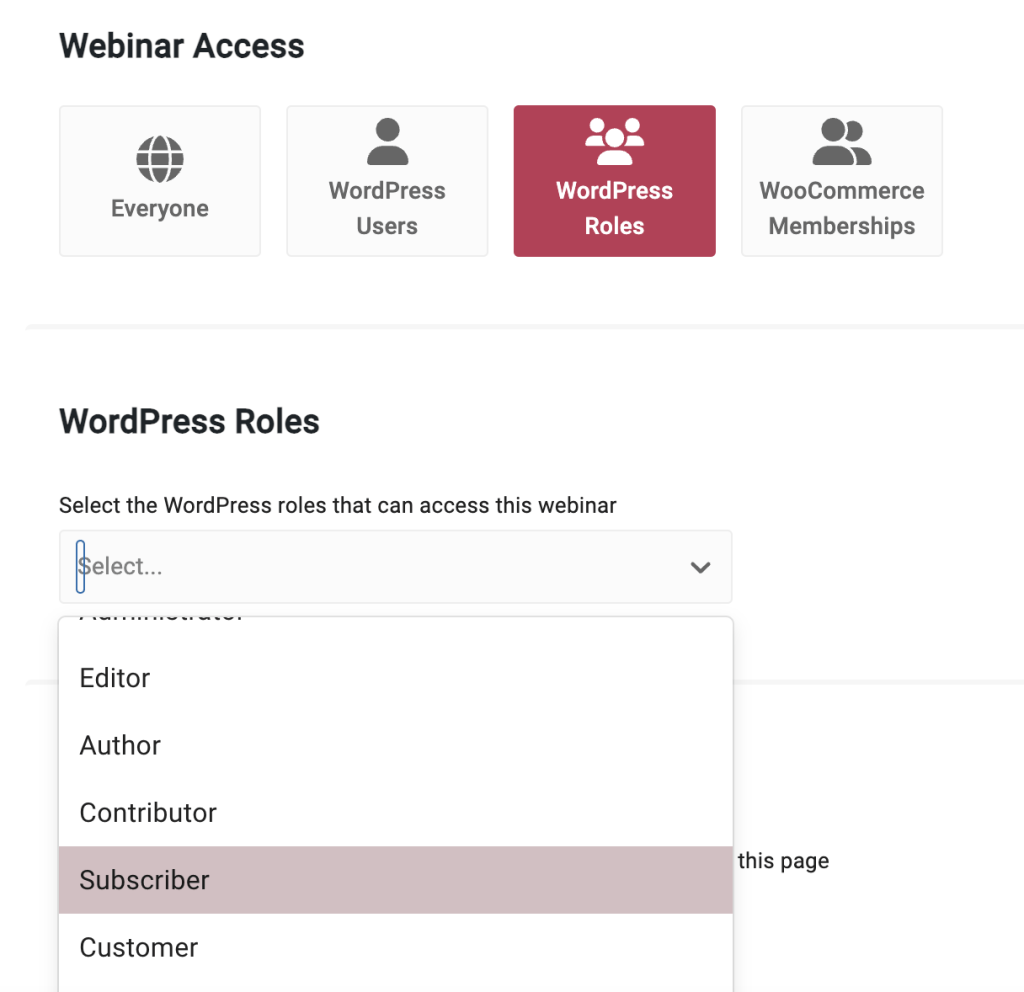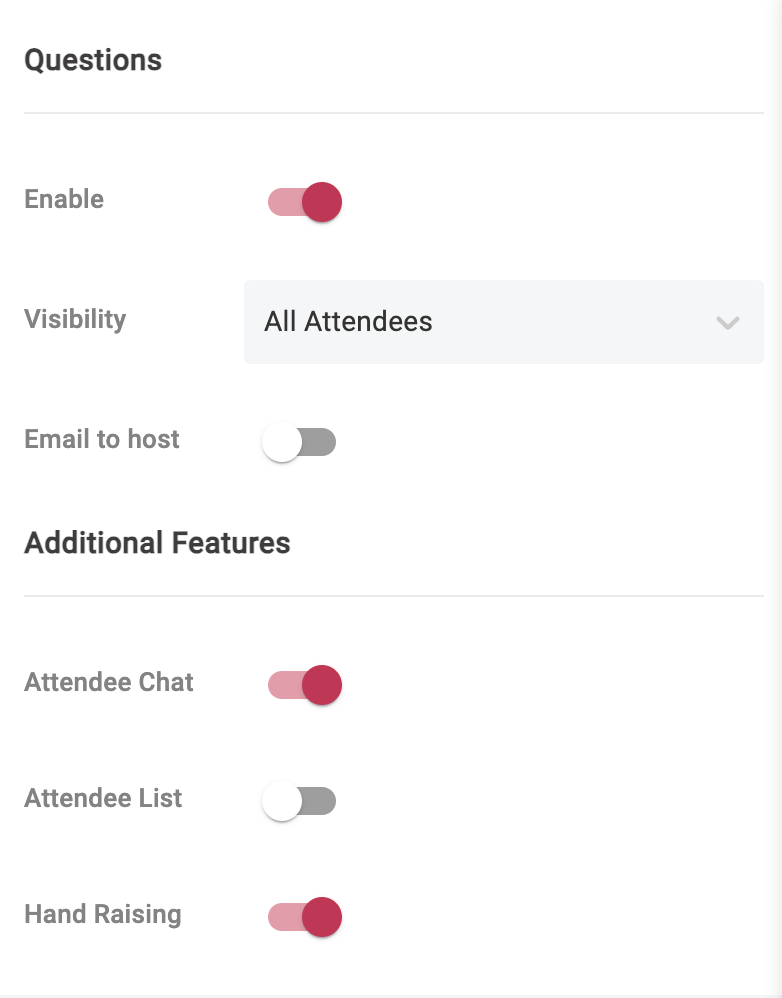Webinars offer a dynamic way to connect with viewers, whether your goal is to boost sales, share knowledge, or simply engage in meaningful dialogue. However, webinars can be tricky to create, run, and manage. Depending on the style of the webinar, you might need to split the work up across several different people.
Once you’re bringing a team into play, you need to define who on the team does what by assigning webinar roles. This decision impacts how each individual interacts with the webinar, from the planning stages through to the live event and its aftermath. This article takes you through the various roles within a webinar, outlining their specific permissions and responsibilities.
Discover how to easily create and manage custom webinars that captivate and engage your audience, making your online presence truly distinctive.
What are the core webinar roles you might need?
Assigning roles for your webinar is a great way to create a well-organized and captivating online event. These roles, each with its distinct set of permissions, serve to organize the webinar and ensure a seamless flow from start to finish. Central to this framework is the principle that not all participants should have the same capabilities. For instance, by default, only the host may have the authority to speak at the beginning, preventing potential chaos and ensuring a smooth kickoff.
Distinct roles give your presentation organization and flow. They ensure that every aspect of the webinar process – sharing info, engaging with the audience, facilitating discussion – all go off without a hitch. The importance of distinct roles extends beyond mere organization. It plays a crucial role in enhancing audience engagement and enriching the webinar with diverse perspectives by incorporating various speakers.
Moreover, different webinar formats need tailored roles and permissions to engage with audiences effectively. For example, a very small webinar for a simple product description might genuinely only need a host. However, a large webinar with a massive panel discussion or Q&A section will need a host, a co-host/moderator, a content creator, a promoter, and of course, panelists.
This section will introduce six pivotal roles commonly observed in webinars, along with the permissions typically granted to these roles.
Host
The host of a webinar is the leader of the event, serving as a crucial anchor that holds the entire event together. This person is responsible for driving the webinar forward, managing its pace, and keeping the audience engaged throughout the presentation. The host can have many duties, or may even manage the entire webinar alone if it’s very small and simple. However, their main focus and role should be focused on soft skills like connection and engagement.
Effective communication and leadership skills are indispensable for a host, as they must guide the discussion, encourage participant interaction, and maintain an engaging atmosphere. Most importantly, the host’s role in ensuring the success and impact of the webinar highlights the significance of selecting the right person for this position.
Co-hosts/moderators
Co-hosts, or moderators, play an important supporting role in the webinar ecosystem, keeping the presentation rolling behind the scenes. Their primary function is to assist in managing various aspects of the webinar so that the event unfolds smoothly and efficiently. This includes helping to moderate discussions, managing participant questions, and addressing any technical issues that may arise during the session.
Co-hosts and moderators are essentially an extension of the host, equipped to step in and take the reins should the need arise, thereby guaranteeing the uninterrupted flow of the webinar. Typically, co-hosts possess permissions that are similar or equal to those of the host, allowing them to perform nearly all the tasks the host can.
However, co-hosts should be given limitations in order to maintain a clear hierarchy and order within the webinar’s management structure. For instance, while a co-host can manage the webinar’s flow and interact with participants, they may not have the authority to end the webinar or appoint other co-hosts.
Content creators
In addition to your hosts and co-hosts, who will drive the actual webinar itself, you need a content creator, who will plan, design, and build the content for the webinar. Unless this role overlaps with another on the list, this person will typically be entirely behind the scenes. They will create the script, define the main points to be covered, and fact-check the information in the content so the webinar is as valuable and accurate as possible.
Although the content creator may not be present for the event itself, they should consult with the members of the team who will be present ahead of the webinar. This way all members of the team can be certain the information is covered accurately. For example, you might have the creator attend a rehearsal or practice run for the webinar, as this will give them a chance to flag any errors or misunderstandings with the hosts or speakers who ultimately will run the event.
Panelists or speakers
Panelists or speakers are key to delivering content in a webinar, and crucial for captivating the audience with their expertise, presentations, and engaging conversations. Their primary responsibility is to provide valuable content that captivates attendees, fostering an environment of learning and engagement. Unlike hosts and co-hosts, the permissions of speakers are more focused on content delivery rather than webinar management.
A key distinction is that speakers can talk directly to the audience without needing explicit permission from the host or signaling their intent to speak. However, they do not have control over webinar settings, such as deciding who can speak at any given time.
For speakers to contribute effectively, certain permissions or workflows are essential. These include the ability to see and respond to audience questions, share their screen for presentations, and use annotation tools to highlight key points. This can be achieved by giving these users permission to do so themselves directly, or by coordinating with co-hosts or moderators to handle these tasks on their behalf as needed.
Promoters
Your webinar team might also include a marketer or promoter, whose job it is to make sure your webinar reaches the right audience. They will likely work directly with hosts, co-hosts, content creators, and speakers both before and after the event to market the webinar effectively. This would include emailing invitations and reminders to potential attendees, promoting the event on social media and across other relevant platforms, and following up on leads afterward.
Your webinar promoter needs to have a keen mind for marketing, and they should collect details – directly or with the help of other members of the team – to enhance their marketing strategy. For example, if you create a custom registration widget that asks demographic questions of your audience, your promoter can use that information to make your webinar marketing better going forward.
Attendees
Attendees’ participation, interaction, and feedback fundamentally shape the success of the event. Although they don’t control the webinar’s direction or content, their participation with questions, comments, and reactions offers valuable insights and enriches the discussion. This transforms the webinar into a dynamic exchange instead of a one-sided presentation.
The importance of fostering active participation from attendees cannot be overstated. However, to maintain order and ensure a productive environment, the host, co-host, or moderator needs to manage questions as they come in and, if there are many, help identify which will be most and least useful. This structured approach allows hosts to encourage participation while preventing potential disruptions or tangents.
Here’s a table that encapsulates the typical permissions across different stages of a webinar:
The importance of clear roles and permissions for your webinars
Without a structured approach to roles and permissions, webinars can quickly become chaotic and unmanageable. You might have to deal with overlapping speaker dialogues, attendee interruptions, and potential security breaches from uninvited guests.
Specific roles and permissions streamline the webinar process, ensuring a smooth, efficient, and engaging session. This structure enhances the professionalism of the webinar and significantly improves audience engagement. Participants know whom to direct their questions to, and speakers understand their cues, creating a seamless flow of information and interaction.
Best practices for assembling a webinar dream team
Creating a successful webinar requires assembling a team with diverse skill sets, where each member plays a role that complements their strengths and experiences.
- The host, for instance, should possess excellent presentation and communication skills to engage the audience effectively.
- Co-hosts, on the other hand, might need to be adept at managing the flow of the webinar and handling any unforeseen issues, requiring strong organizational skills.
- Content creators should be experts in the subject matter. They should be well-trained in both fact-checking and script writing, as well as editing. If they’ll be creating visuals, they should have some level of graphic design know-how as well.
- Promoters should be marketing experts, with a keen sense of how to connect with audiences.
- Panelists should be chosen for their expertise in the webinar’s subject matter, capable of delivering insightful content that captivates the audience.
- Technicians, though not always highlighted, are crucial for troubleshooting any technical issues that arise, ensuring the webinar runs smoothly.
Ultimately, however, the most important thing when managing a webinar team is to make sure everyone knows exactly what their job is and where their responsibilities lie. This way you avoid overlapping tasks, or missing tasks along the way. Clear, well-defined roles make for strong teamwork and smooth sailing.
Setting roles and permissions with WebinarPress
WebinarPress offers a comprehensive solution for WordPress site owners looking to create and manage webinars. This plugin makes it easy to create and manage professional webinars, including features designed to facilitate roles on a webinar. For example, you can give users the “Webinar Moderator” role, which will empower them to run the webinar as a host, co-host, moderator, or presenter.
You can also set restrictions on what kind of user roles can attend your webinar, such as creating a members-only webinar that’s only accessible to subscribers:
Attendee permissions
WebinarPress’s attendee permission settings are important for enhancing the attendee experience, allowing for a balanced level of interaction that boosts engagement while maintaining the webinar’s flow and integrity.
Attendees on the WebinarPress platform typically have access to a set of interactive features that can be customized by the host.
- For instance, during the webinar, the feature that allows attendees to “raise their hands” can be enabled. This lets them signal when they wish to be unmuted or when they have a question or comment, without interrupting the speaker. This function fosters a more organized and interactive discussion.
- Another key feature is the live chat, which can be set to allow public and private messages. Hosts and co-hosts have the authority to delete messages, ensuring the conversation remains relevant and respectful.
- Additionally, the option for attendees to submit questions for approval before they are displayed adds an extra layer of control, allowing hosts to filter out off-topic or inappropriate queries.
To access these settings:
- From the left-hand menu on your WordPress dashboard, select “WebinarPress” and then click the name of the webinar you want to edit.
- In the left-hand menu within the WebinarPress dashboard, select “Webinar” beneath the “Design” header, then choose “Launch Visual Editor.” This will give you access to the features menu pictured above.
Create an effective webinar with WebinarPress
Incorporating webinars into your online strategy opens up a new and interactive method to establish connections with your site visitors. If you want to run a large webinar successfully, you’ll need a team with clear, defined roles set in order to do so.
WebinarPress is an invaluable tool, simplifying the process of creating and organizing webinars directly from your WordPress site. Its extensive customization options for settings allow for a controlled and organized engagement with your audience. It also ensures that each participant can contribute in a meaningful way without throwing the event off track.
Harness the power of WebinarPress today to transform your webinars into captivating experiences that resonate with your audience. Explore WebinarPress and take the first step towards webinar excellence.







